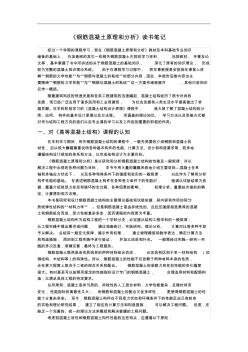Contents
Preface .XI
CHAPTER 1 Introduction. 1
1.1 Development and features of reinforced concrete structure.1
1.2 Characteristics of this course.4
PART 1 MECHANICAL BEHAVIOR OF CONCRETE
CHAPTER 2 Basic Mechanical Behavior9
2.1 Material composition and characteristic10
2.1.1 Composition and internal structure10
2.1.2 Basic characteristics .13
2.1.3 General mechanism of failure process.17
2.2 Compressive strength.19
2.2.1 Cubic compressive strength19
2.2.2 Failure process of prism specimen.21
2.2.3 Main indices of mechanical behavior24
2.3 Complete compressive stressestrain curve.28
2.3.1 Testing method28
2.3.2 Equation for complete curve29
2.4Tensilestrengthanddeformation33
2.4.1Testingmethodandindexoftensilebehavior.33
2.4.2Tensilefailureprocessandcharacteristic39
2.4.3Equationofcompletestressestraincurve42
2.5Shearstrengthanddeformation.44
2.5.1Rationaltestingmethod44
2.5.2Failurecharacteristicandshearstrength48
2.5.3Shearstrainandmodulus.49
CHAPTER3BehaviorUnderIn.uenceofMainFactors.53
3.1Loadactedrepeatedly54
3.2Eccentriccompression.59
3.2.1Testingmethod59
3.2.2Mainexperimentalresults60
3.2.3Stressestrainrelation64
3.3Eccentricand.exuraltensions66
3.3.1Failureprocess66
3.3.2Ultimatetensilestrengthandplasticity-dependentcoef.cient67
3.3.3Themaximumtensilestrainatultimateload69
3.3.4Variationsofstrainandneutralaxisofsection69
3.3.5Equationsforcompletestressestraincurve.70
3.4 Age.71
3.4.1Compressivestrength72
3.4.2Modulusofelasticity74
3.5 Shrinkage75
3.5.1Kindandquantityofcement76
3.5.2Property,size,andquantityofaggregate.76
3.5.3Curingcondition.76
3.5.4Environmentalconditionofservicestage76
3.5.5Shapeandsizeofstructuralmember.76
3.5.6Otherfactors.76
3.6 Creep78
3.6.1Basicconcept78
3.6.2Mainin.uencefactors82
3.6.3Calculationformulas.85
CHAPTER4VariousStructuralConcrete89
4.1 High-strengthconcrete.90
4.1.1Applicationandpreparation.90
4.1.2Basicmechanicalbehavior.92
4.2 Light-weightconcrete99
4.2.1Classi.cation.99
4.2.2Basicmechanicalbehavior.101
4.3 Fiberconcrete.106
4.3.1Classi.cation.106
4.3.2Basicmechanicalbehavior.108
CHAPTER5MultiaxialStrengthandConstitutiveRelation113
5.1 Experimentalequipmentandmethod115
5.2 Generalregularitiesofmultiaxialstrengthanddeformation.118
5.2.1Biaxialstressstates.119
5.2.2Triaxialstressstates122
5.2.3Differentmaterialsandloadingpaths129
5.3 Typicalfailurepatternsandtheirboundaries132
5.3.1Breakingintension.132
5.3.2Columnarcrushing133
5.3.3Splittingintopieces134
5.3.4Inclinedshearing.134
5.3.5Extrudingandshifting135
5.4Failurecriterion137
5.4.1Shapeoffailureenvelopeanditsexpression.137
5.4.2Failurecriterion141
5.4.3Calculationchartsformultiaxialstrength146
5.5Constitutiverelation.147
5.5.1Modelsoflinearelasticity149
5.5.2Modelsofnon-linearelasticity.150
5.5.3Modelsofothercategories.151
PART2 COMBINATIONFUNCTIONOFREINFORCEMENTANDCONCRETE
CHAPTER6MechanicalBehaviorofReinforcement.159
6.1Reinforcementusedinconcretestructure.159
6.1.1Reinforcement(diameter6e40mm).160
6.1.2High-strengthwire(diameter4e9mm)161
6.1.3Shapesteel161
6.1.4Ferrocement162
6.1.5Othersubstitutivematerials162
6.2Stressestrainrelation.163
6.2.1Mildsteel163
6.2.2Hardsteel(wire).166
6.3Deformationunderactionofcyclicloads.167
6.4Behavioraftercold-worked.172
6.4.1Cold-stretchingandage-hardening173
6.4.2Cold-drawn.175
6.5Creepandrelaxation176
6.5.1Kindofsteel.178
6.5.2Sustainingtimeofcontrolstress178
6.5.3Stresslevel178
6.5.4Temperature179
CHAPTER7BondBetweenReinforcementandConcrete.181
7.1Functionandcompositionofbond182
7.1.1Functionandclassi.cation.182
7.1.2Composition184
7.2Testmethodandbondmechanism186
7.2.1Testmethod.186
7.2.2Plainreinforcement.189
7.2.3Deformedreinforcement.190
7.3In.uencefactors.193
7.3.1Strengthofconcrete(fcuorft)194
7.3.2Thicknessofconcretecover(c).195
7.3.3Bondlengthofreinforcement(l).195
7.3.4Diameterandshapeofreinforcement196
7.3.5Transversestirrup(rsv).197
7.3.6Transversecompressivestress(q)198
7.3.7Otherfactors.198
7.4Constitutivemodelforbondstresseslip.199
7.4.1Calculationofcharacteristicvalues.200
7.4.2Equationforsescurve.201
CHAPTER8MechanicalBehaviorUnderAxialForce205
8.1Compressivemember.206
8.1.1Basicequations.206
8.1.2Analysisofstressandstrain(ey
8.1.3Analysisofstressandstrain(ey>ep)210
8.2Tensilemember212
8.2.1Basicequationsforanalysis.212
8.2.2Analysesofstressanddeformationwithineverystage213
8.2.3Minimumreinforcementrate215
8.2.4Tensionstiffening.216
8.3Generalregularity218
CHAPTER9Con.nedConcrete.221
9.1Columnwithspiralbar222
9.1.1Mechanicalmechanismandfailureprocess222
9.1.2Ultimatestrength224
9.2Rectangulartiedcolumn226
9.2.1Failureprocess226
9.2.2Workingmechanismofrectangulartie229
9.2.3Equationforcompletestressestraincurve234
9.3Steel-tube-con.nedconcrete238
9.3.1Mechanicalcharacteristicandmechanism.238
9.3.2Calculationofultimatestrength.241
9.4Localcompression.244
9.4.1Mechanicalcharacteristicandmechanism.244
9.4.2Calculationofstrength.249
CHAPTER10 MechanicalResponseofDeformationDifference253
10.1Shrinkageofconcrete254
10.1.1Generalanalysismethod254
10.1.2Practicalcalculationmethod256
10.2 Difference of thermal deformation259
10.3 Creep of concrete.263
10.3.1 Stress redistribution on section under sustained load .263
10.3.2 Stress state after unloaded265
PART 3 STRENGTH AND DEFORMATION OF STRUCTURAL MEMBER
CHAPTER 11 Strength of Member Under Compression and Bending 269
11.1 Mechanical process and failure pattern.269
11.1.1 Rectangular beam with tensile reinforcement only . 269
11.1.2 Suitably, less-, and over-reinforced beams 272
11.1.3 Eccentrically compressed column (and tensed member)275
11.2 Additional .exure of long column280
11.3 General method for sectional analysis283
11.4 Ultimate strength .289
11.4.1 Calculation formulas 289
11.4.2 Member under biaxial bending 295
11.5 Members of various materials and structural details298
11.5.1 High-strength concrete . 298
11.5.2 Light-weight concrete. 299
11.5.3 Reinforcements with different strengths 300
11.5.4 Reinforcement without yielding plateau301
11.5.5 Reinforcements distributed along sectional depth.301
11.5.6 Non-rectangular sections 303

 钢筋混凝土原理与分析
钢筋混凝土原理与分析

 钢筋混凝土基本原理E
钢筋混凝土基本原理E